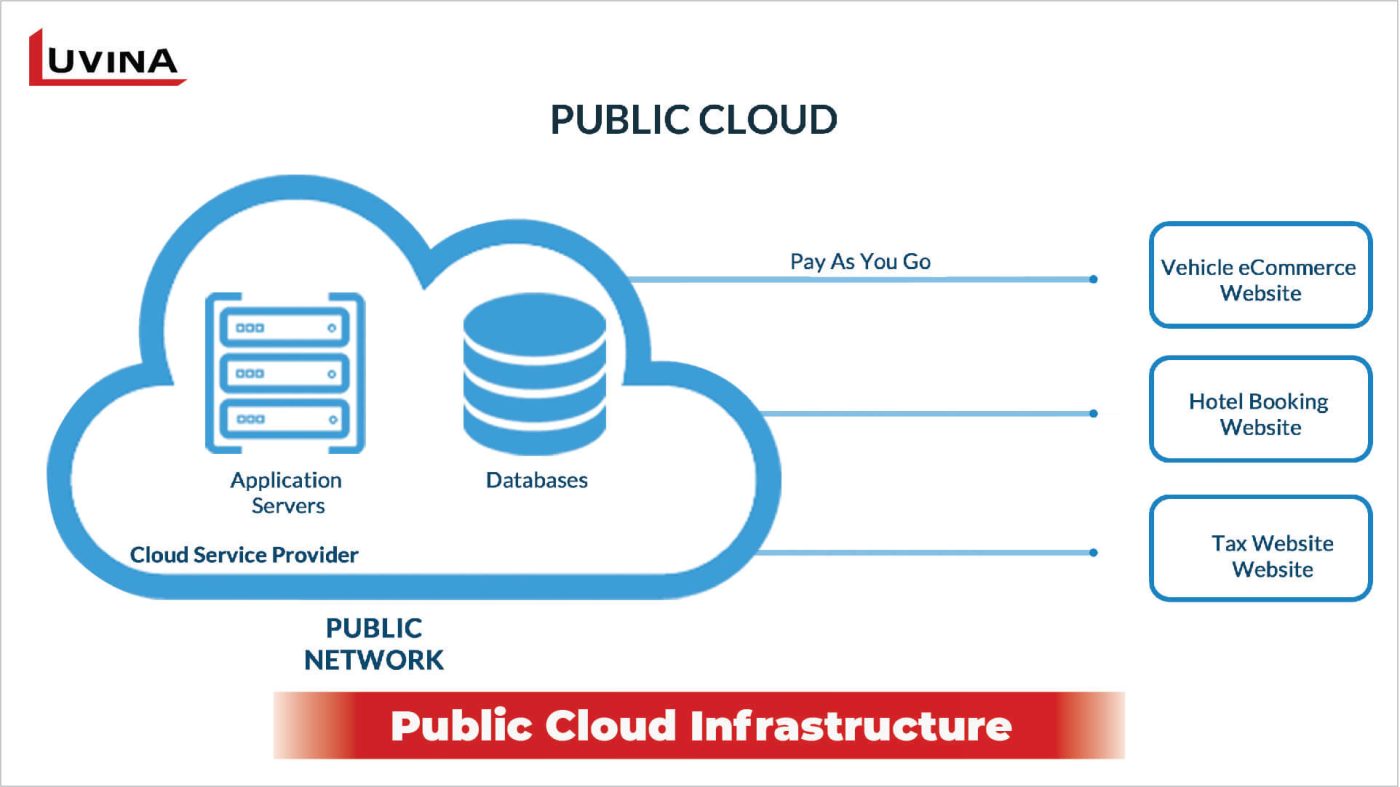Public cloud deployment models have taken the business world by storm, revolutionizing how organizations manage their IT infrastructure. With the promise of cost-efficiency, scalability, and accessibility, public clouds offer a dynamic solution for businesses of all sizes. In this article, we will explore the ins and outs of public cloud deployment models, shedding light on the many advantages they provide.

Unraveling Public Cloud Deployment Models
Public cloud deployment models involve leveraging a cloud service provider’s infrastructure to host applications, data, and services. This provider manages and maintains the underlying hardware, software, and overall infrastructure, offering these resources as services to clients on a pay-as-you-go basis. Accessible over the internet, public clouds are renowned for their scalability, ease of use, and shared resource model. This shared infrastructure model allows multiple users or organizations to utilize the same pool of resources, benefiting from the provider’s vast infrastructure without the need for individual hardware investment or maintenance. The scalability of public clouds allows users to easily scale resources up or down based on demand, enabling flexibility and cost-efficiency by paying only for the resources consumed. This accessibility, scalability, and shared resource model characterize the fundamental attributes of public clouds, making them popular choices for a wide range of businesses and applications.

Advantages of Public Cloud Deployment Models
Public cloud deployment models come with numerous advantages, making them an attractive option for businesses across the globe. Let’s delve into these advantages:
1. Scalability and Flexibility
Absolutely, the scalability and flexibility offered by public clouds stand as key advantages for organizations, empowering them to swiftly adjust their computing resources in response to fluctuating demands. This capability allows organizations to easily scale resources up or down based on workload variations, providing unparalleled agility in accommodating changing business needs. In today’s dynamic business landscape, where workloads may experience rapid fluctuations due to seasonal demands, market trends, or unexpected spikes in user traffic, the ability to scale resources dynamically is invaluable. Public clouds enable businesses to efficiently manage these fluctuations, ensuring optimal performance and resource utilization without the need for substantial infrastructure investments or pre-planning for peak demands. This scalability and flexibility attribute of public clouds underpin their appeal, offering organizations the agility to adapt and respond quickly to evolving business conditions while ensuring cost-effectiveness and operational efficiency.
2. Cost-Efficiency
Public clouds are celebrated for their cost-efficiency, offering businesses substantial savings by circumventing the expenses linked with maintaining and upgrading on-premises infrastructure. The pay-as-you-go pricing models prevalent in public clouds allow organizations to pay only for the resources they consume, making it an extremely cost-effective choice. This consumption-based pricing eliminates the need for upfront investments in hardware or software, reducing capital expenditures. Furthermore, organizations are relieved from the financial burden of infrastructure maintenance, upgrades, and ongoing operational costs associated with on-premises solutions. The scalability and flexibility inherent in public clouds enable businesses to align their resource usage precisely with actual demands, optimizing resource utilization and further contributing to cost savings. Overall, the pay-as-you-go pricing model, coupled with the ability to scale resources and the avoidance of infrastructure maintenance costs, renders public clouds a budget-friendly option for businesses seeking cost-efficiency and financial flexibility.
3. Accessibility and Ease of Use
Public clouds are incredibly accessible and user-friendly. These self-service capabilities grant businesses the autonomy to swiftly adapt to market changes and evolving requirements without extensive technical expertise or intervention from cloud service providers. Users can easily provision computing resources, deploy applications, and configure services through intuitive user interfaces and robust management consoles offered by public cloud providers. This accessibility fosters agility and responsiveness, enabling organizations to scale resources, adjust configurations, and innovate rapidly in response to changing business needs or market dynamics.
Additionally, the user-friendly nature of public clouds encourages experimentation and exploration, allowing businesses to test new ideas or deploy prototypes quickly, facilitating a culture of innovation and continuous improvement within the organization.
Overall, the accessibility and user-friendliness inherent in public clouds play a pivotal role in enabling businesses to adapt swiftly, innovate efficiently, and remain competitive in today’s dynamic business landscape.
4. Robust Infrastructure
Public cloud service providers maintain robust and reliable infrastructure. This ensures high availability, data redundancy, and disaster recovery capabilities, reducing downtime and data loss risks. These providers typically operate data centers across multiple geographic locations, ensuring redundancy and fault tolerance. The distributed nature of their infrastructure minimizes the risk of service interruptions or downtime due to hardware failures or localized outages.
Furthermore, public cloud providers implement sophisticated data redundancy mechanisms, replicating data across multiple servers or data centers within their network. This redundancy strategy ensures data resilience and protects against potential data loss scenarios.
Additionally, public cloud services offer comprehensive disaster recovery solutions, enabling organizations to implement backup and recovery strategies efficiently. Leveraging these disaster recovery capabilities, organizations can swiftly recover data and services in case of unexpected disruptions or catastrophic events.
Overall, the robust infrastructure, high availability, data redundancy, and disaster recovery capabilities maintained by public cloud service providers serve as critical pillars in reducing downtime and data loss risks, bolstering reliability, and ensuring continuous service availability for businesses utilizing these cloud services.
5. Broad Range of Services
Public clouds provide a diverse and extensive range of services and applications, offering clients a comprehensive suite of tools and solutions tailored to meet a broad spectrum of needs and requirements. Clients have the flexibility to choose from a vast array of services provided by public cloud vendors, ranging from foundational infrastructure services like storage and computing to advanced and specialized solutions such as machine learning, artificial intelligence, data analytics, Internet of Things (IoT), and more. This expansive service portfolio enables organizations to access cutting-edge technologies and innovative tools without the need for substantial upfront investments in infrastructure or software development. The availability of these diverse services within public clouds allows clients to select and utilize the precise tools and solutions that align with their specific business objectives, enabling them to innovate, scale, and drive efficiency in various aspects of their operations.
Overall, the wide array of services and applications offered by public clouds caters to the diverse needs of clients, empowering them with the flexibility and capabilities to address various challenges and opportunities within their business domains.
>> See more: The Advantages of Hybrid Cloud Deployment Models
Factors to Consider
While public cloud deployment models offer a plethora of benefits, businesses must consider critical factors such as data security, compliance requirements, and long-term costs when contemplating their cloud strategy. The security and protection of sensitive data remain a paramount concern for organizations, necessitating a thorough assessment of how data will be managed, stored, and secured within the public cloud environment. Compliance with industry-specific regulations and data protection laws also stands as a critical consideration, influencing decisions regarding data residency, access controls, and encryption practices within the public cloud infrastructure.

Moreover, while the pay-as-you-go model of public clouds is cost-effective for many use cases, a careful evaluation of long-term costs is essential. Understanding the total cost of ownership (TCO), considering factors like ongoing operational expenses, potential scalability costs, and additional services, aids in making informed decisions about the sustainability and cost-effectiveness of a public cloud approach.
Striking the right balance between public and private cloud usage is crucial. A hybrid cloud strategy allows organizations to leverage the strengths of both deployment models, optimizing resources based on workload requirements, data sensitivity, and performance needs. This hybrid approach enables organizations to enjoy the scalability and cost-efficiency of the public cloud while ensuring security, compliance, and control over sensitive data within the private cloud model.
Ultimately, a well-thought-out cloud strategy aligns the benefits of public clouds with specific organizational needs, balancing efficiency, security, compliance, and long-term financial considerations to drive optimal business outcomes.
Conclusion
Public cloud deployment models have undoubtedly changed the way businesses manage their IT resources. Their scalability, cost-efficiency, accessibility, robust infrastructure, and vast service offerings make them a compelling choice for organizations seeking efficiency and agility. By assessing their unique requirements, organizations can capitalize on the advantages of public clouds, stay competitive in the market, and embark on their digital transformation journey with confidence.
In a fast-paced digital world, public cloud deployment models are likely to continue shaping the IT landscape. As businesses adapt to the evolving needs of their operations, public clouds offer an efficient and flexible solution to meet these demands. By harnessing the advantages of public clouds, organizations can navigate the digital era while achieving their goals with ease.
{ Get everything you ever
wanted to know about IT.}








Read More From Us?
Sign up for our newsletter
Read More From Us?
Sign up for our newsletter